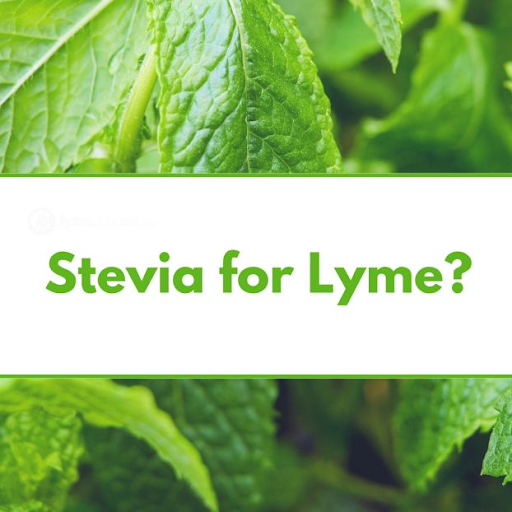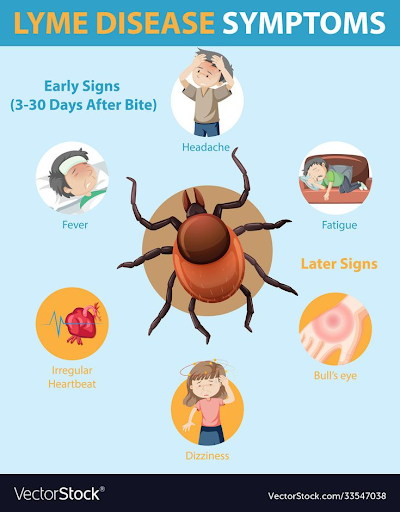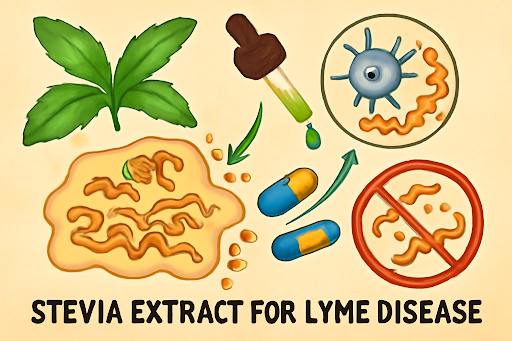
Have you heard of stevia sweeteners that do not contain calories? Some sweeteners in this category are considered low calorie, while other types do not contain any calories. Does stevia aid in your healing journey?
Lyme disease is caused by the bacteria, “Borrelia burgdorferi”, that are spread through a tick bite. Antibiotics and lifestyle modifications play an important role in treating the clinical symptoms of Lyme disease. In this blog, we will explore how stevia can contribute to the healing of Lyme disease patients.
What exactly is stevia?
Stevia is a natural sweetener that contains low calories. The sweetness is produced due to a natural ingredient, called steviol glycoside that are found in the leaves. It is 400 times sweeter than the refined sugar (sucrose). According to the research, stevia sweeteners are generally safe to use and are associated with health benefits.
It has been estimated that stevia is safe to use in individuals with diabetes, hypertension, and obesity. Studies have also found that stevia can be used in the prevention/treatment of diseases. Stevia sweeteners can be used in juices, dairy products, chocolates, etc.
When these sweeteners reach the colon, the gut microorganisms break down the glucose molecules and utilize them as an energy source. The remaining sweetener gets metabolized by the liver and is then excreted through urine.
What is the link between stevia and Lyme disease?
Lyme disease is caused by the bacteria, “Borrelia burgdorferi”, which leads to clinical manifestations, such as musculoskeletal pain, facial nerve paralysis, skin rashes, meningitis, depression, insomnia, etc. Around 80% of Lyme disease cases can be treated with antibiotics. Out of the treated cases, 20% will develop into antibiotic-resistant cases.
The bacteria produce a protective biofilm that attaches to the body surface of the host. The spirochetes adjust to the environmental conditions, and they become resistant to treatment.
Studies have estimated that Stevia rebaudiana is a potent antimicrobial agent and acts against different forms of bacteria.
Different microscopic techniques were used to evaluate the efficacy of both the antibiotics and the sweetener. It was found that stevia eliminated the bacteria by 94%, when compared to antibiotics. A 14-day subculture of the sweetener reduced the growth of Borrelia burgdorferi, when compared to doxycycline.
These techniques demonstrated that stevia has potent antimicrobial properties when compared to cefoperazone, daptomycin, etc.
What are the clinical symptoms of Lyme disease?
The early clinical signs of Lyme disease occur within a period of 30 days after the bite of an infected tick. Initially, erythema migrans/skin rashes appear that affects around 70-80% of people. These rashes appear at the site of the tick bite and gradually expand in size. The rashes can be itchy and feel warm to touch. In the later stages, the patient can suffer from
- Facial nerve paralysis
- Stiffness in the neck region
- Headache
- Trouble breathing
- Neuropathic pain
- Palpitations
- Numbness or tingling sensation in the upper and lower extremities

What are the conventional treatment approaches for Lyme disease?
Antibiotic treatment is the keystone of the therapy that works best when it is used at the early stages. In the early stage of localized Lyme disease, oral administration of antibiotics is preferred.
Intravenous antibiotics are recommended in later stages, where the infection spreads to other body parts (e.g. the joints, the heart or the nervous system). Anti-inflammatory medicines can help to cope with the pain. Lifestyle changes, healthy diet, and regular exercises can help to improve the clinical symptoms.
How does stevia help in eliminating the bacteria that cause Lyme disease?
Studies have estimated that stevia has the potential to hamper the growth of the bacteria, particularly when placed in alcohol-containing formulas. Borrelia burgdorferi forms protective biofilms that prevent the action of antibiotics, which can lead to chronic infections.
Stevia extracts have the ability to disrupt bacterial biofilms, which makes the bacteria susceptible to immune destruction. Stevia has the ability to eliminate the forms of bacteria that are resistant to antibiotics.
Stevia has a synergistic effect when combined with traditional antibiotics. Hence, it can be used as a natural adjunctive treatment of Lyme disease that can lead to a better prognosis.

What are the diagnostic tests used to detect Lyme disease?
The diagnosis of Lyme disease can get complicated due to a variety of symptoms that accompany the disease and tend to confuse it with other illnesses. Diagnosis is most often made by a combination of clinical assessment, exposure history to tick bites and laboratory testing.
The most common approach is the two-level serologic method suggested by the Centers for Disease Control and Prevention (CDC). Enzyme-linked immunosorbent assay (ELISA) identifies the antibodies (IgM and IgG) against Borrelia burgdorferi.
As ELISA can give false positive results, a Western blot test is performed to confirm specificity. Western blot detects antibodies against individual Borrelia proteins. These two tests rely on the immune response of the body. Hence, it cannot indicate the infection at an early stage before the development of antibodies. Clinically, erythema migrans can be used as a diagnostic aid for identifying Lyme disease.
Polymerase chain reaction (PCR) can help in detecting Borrelia DNA in the blood or cerebrospinal fluid. Though PCR is very specific, it is not sensitive and cannot be applied to any patient.
Early and precise diagnosis is vital since immediate treatment leads to significant improvement in prognosis and diminishes the possibility of developing complications in the long term.

Conclusion:
- Healing of Lyme disease becomes difficult for patients who experience persistent clinical symptoms, even after antibiotic treatment.
- Apart from antibiotic treatment, stevia extracts can be used to eliminate bacterial biofilms and target the resistant forms.
- Hence, stevia can be considered as an adjunctive therapy that can support traditional treatment.
References:
- Theophilus PAS, Victoria MJ, Socarras KM, Filush KR, Gupta K, Luecke DF, et al. Effectiveness of Stevia rebaudiana whole leaf extract against the various morphological forms of Borrelia burgdorferi in vitro. Eur J Microbiol Immunol (Bp). 2015 Dec;5(4):268–80. Available from: https://www.ncbi.nlm.nih.gov/pmc/articles/PMC5651958/ [cited 2025 Jun 28].
- Smith J. Stevia Shown to be Effective Against Lyme Disease. Natural Health Research Institute. 2018 Jul 18 [cited 2025 Jun 28]. Available from: https://www.naturalhealthresearch.org/stevia-shown-to-be-effective-against-lyme-disease/
- Centers for Disease Control and Prevention. Signs and Symptoms of Untreated Lyme Disease. CDC. 2024 May 15 [cited 2025 Jun 28]. Available from: https://www.cdc.gov/lyme/signs-symptoms/index.html
- Peteliuk V, Rybchuk L, Bayliak M, Storey KB, Lushchak O. Natural sweetener Stevia rebaudiana: Functionalities, health benefits and potential risks. EXCLI J. 2021 Sep 22;20:1412–30. Available from: https://www.ncbi.nlm.nih.gov/pmc/articles/PMC8600158/ [cited 2025 Jun 28].







